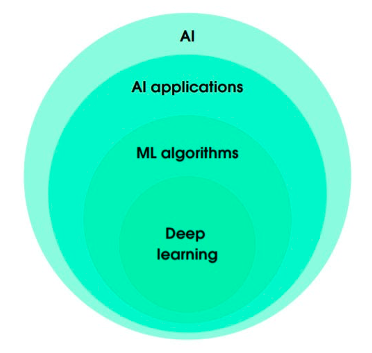
With uses spanning personalized medicine to the creation of social media clickbait, the use of artificial intelligence (AI) and machine learning (ML) is expected to transform industries from health care to manufacturing. Web scraping is no exception – and while its use is definitely not the answer to every data collection challenge, simple applications of AI/ML can enhance the process and increase web scraping success.
This article is going to outline how we are using AI and ML to drive web scraping innovation forward. Since AI is a big (and often misinterpreted) topic, we’ll go over some AI-related concepts first and then explain how they work together. Then we’ll review the data extraction process and how AI and ML are already enhancing currently available web scraping solutions.
AI, ML, and Deep Learning Defined
AI, ML, and deep learning have become buzzwords that are used interchangeably (often incorrectly) in some contexts. Let’s first define what they mean and how they differ before diving into how they are being used.
Artificial intelligence is a general term that refers to the ability of a machine to think and act in a way that mimics human intelligence. The “artificial” part refers to the electronic device itself while the “intelligence” part describes the ability of the machine to collect data and learn from it in a way similar to how humans process information.
AI applications refer to the use of AI in software programs that fulfill a specific purpose. Some typical AI applications familiar to the mainstream public include self-driving cars, digital “assistants” on mobile phones or home devices, and YouTube algorithms that “learn” user preferences and suggest videos to watch. Use cases for applied AI continue to grow across many industries, such as its use in fraud detection and trading software by investment firms and to diagnose patients in the biotech and health care spaces.
Machine learning refers to specific algorithms used by AI applications. In plain terms, ML processes data, “learns” from it, and then makes a decision about what to do with the information. ML makes use of randomness or probability when making decisions. This concept is critical to understand because the stochastic nature of ML algorithms allows for the continued progression of “intelligence” by those programs.
Deep learning – the most in-depth part of the process – takes those algorithms and uses them to derive conclusions through logical analysis. The design of deep learning is inspired by our own neural network composed of neurons – cells that receive input –bridged by synapses carrying information from one point to the next.
Here is a simple visualization summarizing how these primary concepts are related:

Can Web Scraping Benefit from AI?
Now that we have a basic understanding of the various facets of AI, let’s take a step back and analyze the web scraping process to fully answer this question.
Generally speaking, web scraping is the process of using scripts (or “bots”) to crawl a website and extract data. This is most often accomplished successfully with the use of proxies to provide different IP addresses and prevent server issues.
AI and ML can be used to enhance various processes along the web scraping value chain, especially with time-consuming and tedious tasks that require governance and quality assurance. Since the use of AI-related technology increases efficiency and data extraction success, it also holds immense potential for helping web scraping operations scale up effectively.
AI and ML Improve Data Fetching and Parsing
Data gathered from a website is often returned in a raw code format where the results are somewhat cryptic and difficult to read. Parsing is the process that makes that data usable.
Maintaining a parser requires a great deal of work and maintenance. Adapting it to different website formats and structures is a constant challenge. To address these challenges, an AI/ML-powered solution can simplify developer workflow by parsing data from specific domains because it “understands” how those websites are structured.
For example, our clients have always struggled with working out structured public data from e-commerce pages. These sometimes have several different parsers for a set of pages. Thus, developing an adaptive parser solution that would, well, adapt to layouts and provide parsed data was the perfect candidate. With the help of machine learning, our clients can now retrieve parsed public data from a wider variety of e-commerce pages without having to worry about developing dedicated parsers.
AI and ML-Powered Proxies Address Complex Scraping Challenges
Proxies act as an intermediary that helps distribute requests, maintain anonymity, and prevent server issues. Like many parts of the web scraping value chain, they are an essential part of the web scraping process and require constant management and infrastructure maintenance.
At my company, we have found novel ways to leverage AI and ML to overcome many of these issues with our Next-Gen Residential Proxies. They work just like regular proxies to include customization, custom header support, IP stickiness, reusable cookies, and POST requests. At the same time, they leverage AI and ML to allow adaptive HTML parsing, advanced block avoidance, dynamic fingerprinting, an auto-retry system, and JavaScript rendering to gather public data from complex targets.
Want to Learn More?
The field of AI and ML-powered data scraping solutions is so vast and unexplored that there’s room for everyone. We’re hoping to see more implementations over the coming years.
